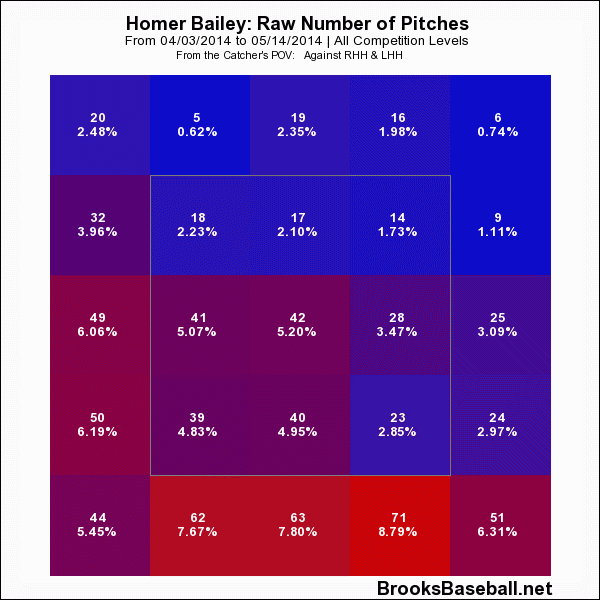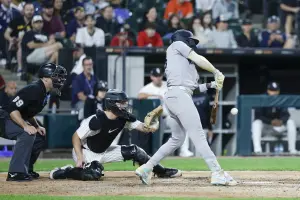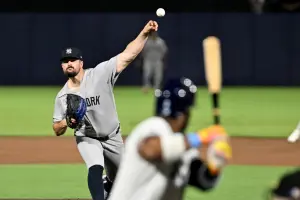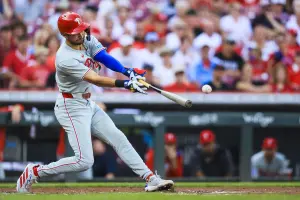
(*)F/F SPOTLIGHT: Homer Bailey
Homer Bailey (RHP, CIN) is having the type of season thus far which has often plagued him in the past. He currently has a 4.72 ERA and a 1.51 WHIP, which resembles the numbers he had in 2009 when he first became a fantasy frustration. This comes on the heels of arguably the best season of his career. Did he take one step forward to take two steps back?
Setting The Stage
Homer Bailey was the seventh player taken in the 2004 amateur draft. He was the sixth of seven consecutive pitchers taken in that draft: Justin Verlander, Philip Humber, Jeff Niemann, Mark Rogers, and Jeremy Sowers were taken in front of him, and Wade Townsend was taken after him. During his time in the minors, Bailey was ranked ranked as a top 50 prospect by Baseball America four different times: 2005 (48), 2006 (38), 2007 (5), and 2008 (9). He was considered Cincinnati’s top prospect each season from 2005 to 2007 and finished second to Jay Bruce in 2008. The first BaseballHQ.com player note entry for Homer Bailey set the stage for what to expect for his career:
6/9/2007 - Homer Bailey (RHP, CIN) made a grand entry into the Major Leagues when he won his first MLB start against the powerful Cleveland Indians Friday night. Pundits are forecasting stardom for Bailey due to his 2.32 ERA and 1.08 WHIP at Triple-A Louisville this year, but when we note his minor league Ctl (3.7), Dom (7.9) and Cmd (2.13), we should expect games like Friday night when Bailey walked more batters (4) than he struck out (3). Bailey has a very bright future and is an exceptional long term play, but we should expect a few bumps along the way.
New Contract For A New Pitcher
It was not until Bailey’s sixth season in the major leagues that he threw more than 140 innings, and he made the workload jump from 132 innings to 208 that season. In 2013, he followed up that first 200+ inning effort with the best season of his career and continued his process of improving each year in multiple areas. His BPV has improved each season of his major league career while other components such as his WHIP, Cmd, and SwK did so over multiple seasons as well.
Year IP ERA xERA WHIP H% S% Ctl Dom Cmd SwK G/L/F hr/9 BPV ==== === ==== ==== ==== === === === === === === ======== ==== === 2007 45 5.76 5.41 1.57 29% 62% 5.6 5.6 1.0 9% 47/18/35 0.6 -25 2008 36 7.93 5.76 2.09 38% 65% 4.2 4.5 1.1 6% 43/25/31 2.0 -12 2009 113 4.53 4.57 1.47 31% 71% 4.1 6.8 1.7 8% 43/21/37 1.0 32 2010 109 4.46 3.83 1.37 32% 69% 3.3 8.3 2.5 9% 42/21/37 0.9 79 2011 132 4.43 3.86 1.28 31% 69% 2.3 7.2 3.2 10% 39/22/38 1.2 86 2012 208 3.68 3.92 1.24 30% 75% 2.3 7.3 3.2 10% 45/20/35 1.1 93 2013 209 3.49 3.29 1.12 29% 72% 2.3 8.6 3.7 11% 46/19/34 0.9 115 2014 48 4.72 3.63 1.51 35% 73% 3.0 8.3 2.8 10% 51/18/30 1.5 97
There were enough indicators trending in the right direction for Cincinnati to feel comfortable offering the hurler a contract extension this past offseason which will keep him with the team an additional six seasons for $105 million. Experts were also keen on Bailey this season, as he went for $16 in the Mixed Tout Wars auction and $17 in the NL-Only auction. Expectations for Bailey were high, but so far, the results have not answered the bell.
2014 Start
Where has Bailey gone wrong so far coming off his career season:
Year IP ERA xERA WHIP H% S% Ctl Dom Cmd SwK G/L/F hr/9 BPV ==== === ==== ==== ==== === === === === === === ======== ==== === 2013 209 3.49 3.29 1.12 29% 72% 2.3 8.6 3.7 11% 46/19/34 0.9 115 2014 48 4.72 3.63 1.51 35% 73% 3.0 8.3 2.8 10% 51/18/30 1.5 97
There is some good mixed in the bad for the now well-paid pitcher:
- His Dom rate is still well above the league average, as is his Cmd and SwK rate.
- Despite putting his fair share of runners on base and the high hr/9 rate, he has still been able to strand runners above the league average rate for starting pitchers.
- The 1.16 run gap between his ERA and xERA point to the room for improvement in his performance as his hit rate normalizes to where it has been since he has been a regular starter in the major leagues.
- The high hr/9 rate comes despite the fact Bailey is posting a career-best 51% groundball rate. The 17% HR/F ratio is nearly six full percentage points above his previous career high.
Bailey, game-by-game
DATE OPP DEC PC PQS W IP H ER HR BB K SwK GB LD FB ======= ==== === === === = === = == == == == === == == == 4/3/14 STL L 93 0 0 4.3 7 4 1 3 3 6 11 4 1 4/8/14 @STL ND 99 3 0 5.0 9 4 1 2 5 6 9 7 1 4/14/14 PIT ND 104 2 0 5.0 8 5 4 0 9 21 4 2 8 4/20/14 @CHC W 96 5 1 6.0 6 0 0 3 8 10 5 2 8 4/25/14 @ATL L 94 4 0 6.0 9 5 1 0 4 12 11 4 6 5/1/14 MIL W 108 4 1 8.0 8 3 0 1 4 9 15 3 8 5/6/14 @BOS ND 110 4 0 6.0 5 3 0 5 5 5 12 3 3 5/11/14 COL W 112 5 1 7.3 4 1 1 2 6 15 8 2 9
He stumbled out of the gate against St. Louis and continued those struggles against Pittsburgh. Since then, Bailey has posted five consecutive PQS-DOM starts against some tough opponents, especially in his last three games. The loss against Atlanta was frustrating given that team's extreme swing-and-miss tendencies, but wins against Milwaukee and Colorado are very encouraging. Those two teams are two of the best offenses in baseball, and he disposed of both rather handily.
While his groundball rate is at a career-best 51%, it is not that far ahead of last season’s pace. Bailey made 32 starts last season and generated at least 10 groundballs in 12 of those 32 starts. With four such efforts through his first nine starts, he is on pace to best last season’s total sometime in mid to late September.
Where did the groundballs come from?
Bailey’s groundball rate had improved each of the previous three seasons heading into 2014, but the jump over 50% this season has everything to do with his fastball.
.png)
Bailey is doing a better job of getting that pitch down in the zone, and when he hits his spot with it, batters are having a tough time elevating it. The frequency by which Bailey is locating his fastball down in the zone is rather noticeable.

The increase in groundballs has left him more susceptible to hit-rate damage and his 35% hit rate is the highest of his career. Groundballs become hits at a higher rate than do flyballs, but that has already started to normalize. He had a 43% hit rate over his first three starts and has had a 31% hit rate since. Six of his eight home runs came to the first 70 batters he faced in 2014; he has permitted just two to the last 139 batters he has faced.
What else has Bailey changed?
The only noticeable change to Bailey’s approach to batters this season in terms of pitch use is that he is throwing more sliders. He has thrown sliders 22% of the time this season, which is his highest rate since 2011, when he used the pitch 21% of the time. He is not getting more swinging strikes, though; the rate on the pitch is actually slightly lower this season than it was in 2013. The swinging strikes are coming from his splitter, even though he using that particular pitch less frequently than he did in 2013. He has thrown 87 splitters this season and has generated 25 swings and misses on those pitches. However, part of his recent success has been related to eschewing the strikeout and looking to generate weaker contact.
The other part of the recent success is that he is excelling at something former pitching coach Rick Peterson has repeatedly stressed to pitchers. Peterson is a strong advocate of the importance of a quality pitch in a 1-1 count, and for a good reason. Note the difference in the league-wide in outcomes in recent seasons after counts reach 1-2 versus 2-1:
Count BA OBP SLG K% BB% H% ========= ==== ==== ==== === === === After 1-1 .239 .308 .374 24% 9% 30% After 1-2 .180 .229 .273 40% 5% 29% After 2-1 .257 .391 .416 19% 18% 30%
Over his first three starts, Bailey was throwing strikes in 1-1 counts just 55% of the time, giving up the advantage and giving batters a better chance of turning that plate appearance into a hit or getting on base. Over his last five starts, Bailey has thrown a strike 71% of the time, which has allowed him to seize the statistical high ground in a matchup and put batters on the defensive with their approach. Those types of defensive swings lead to weak contact and the types of results that have helped Bailey turn around his unproductive start to the season.
Conclusion
Stephen Nickrand’s latest player note on Bailey says it best. No other starting pitcher had a worse combination of H% and hr/f misfortune than Bailey had in April despite a strong Dom, Ctl, and BPV. His overall numbers are still going to turn some people off, but the strong skills are still lying beneath those surface stats screaming to come out. They’ve clawed and scratched their way towards the top and it won’t be long until others will take notice. The fact he shut down Colorado after an early home run to Charlie Blackmon probably caught the attention of others and the window to buy low on Bailey is rapidly closing.
The skills are there, and while he may still hit a few of those bumps along the line, he looks to be realigned to what made him successful in 2013 with a few enhancements that should allow him to flourish the rest of the way.








